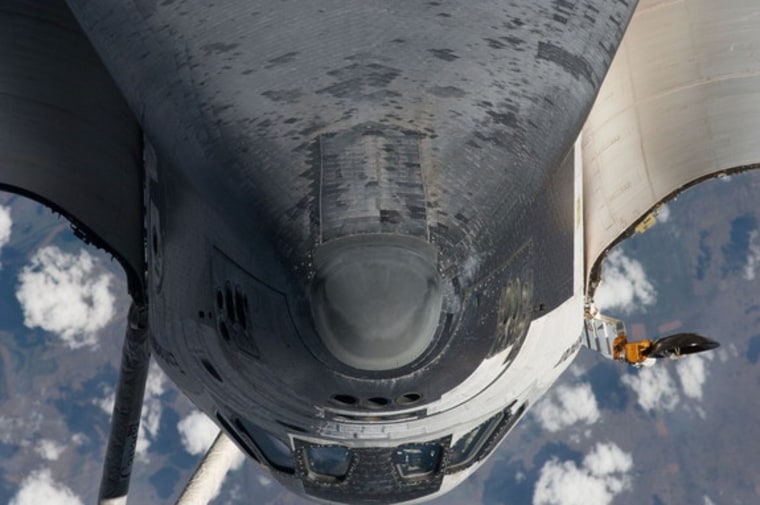NASA engineers are taking a close look at several spots on the space shuttle Endeavour's belly where its vital heat shield tiles were during the spacecraft's launch earlier this week.
Endeavour blasted off Monday (May 16) to begin a 16-day trip to the International Space Station. It is the shuttle's last mission before the orbiter is retired to a museum. [Photos of Shuttle Endeavour's Final Launch]
The damaged spots are on Endeavour's heat shield, which protects the spaceship from the fiery temperatures it experiences when re-entering Earth's atmosphere.
Most likely, the damage will turn out to be of no consequence, NASA officials said, but for now they must continue to analyze the patches to make sure.
"I am not concerned about the damage that we're seeing here," LeRoy Cain, chair of Endeavour's mission management team, told reporters Thursday (May 19). "It's certainly not alarming, and the team is not concerned about it."
NASA has kept a close eye on the health of space shuttle heat shields during mission since the tragic 2003 loss of the shuttle Columbia. A piece of fuel tank debris damaged Columba's heat shield during launch, leading to the shuttle's destruction during re-entry. Seven astronauts were killed.
Since then, shuttle astronauts have conducted several in-space inspections of their spacecraft to make sure the vehicle is safe for re-entry. Several repair tools and techniques are also available, should they be needed.
The damage on Endeavour is not on the same scale as that during the Columbia accident.
Photos of Endeavour's heat shield taken during a routine inspection by shuttle astronauts after launch, as well as by the space station's crew before the shuttle docked at the orbiting lab yesterday, revealed seven areas of damage, Cain said.
Of those seven spots, mission managers have already dismissed five of those since they pose no risk, Cain added. Mission managers are very close to clearing a sixth, he said.
But one area about 3.2 inches (8.1 centimeters) long and 2.5 inches (6.4 cm) wide may still pose a potential hazard, and requires further study to be sure.
It's possible NASA will need to have the Endeavour astronauts go forward with an extra heat shield inspection to gather better photos of the area for closer analysis. This activity, called a focused inspection, is relatively rare.
NASA has only had to conduct focused inspections four times since adding them as an optional activity to every shuttle mission following the Columbia shuttle accident.
"The team has not completed our assessments on this site, but the work we've done so far, we believe that we may need to do a focused inspection in order to get some fidelity," Cain said. The existing pictures of that area, he said "are kind of fuzzy."
Most likely, if such an inspection is necessary at all, it will be all that's needed to clear the last spot of any potential risk to the orbiter, Cain said.
"I feel pretty confident that if in fact were not able to clear it by the morning, when we get the focused inspection data that we'll be able to clear this problem and not have to do anything," he said.
If, however, it does turn out that the damaged area make the vehicle unsafe to fly back to Earth, NASA has options to fix it.
"We do have some repair capability," Cain said. "Astronauts would go out with a gun-type applicator and we put some material in the cavity. We also have what's called tile overlay. We have a lot of confidence in both of those repair capabilities if we should need to use them."
You can follow SPACE.com senior writer Clara Moskowitz on Twitter @. Visit SPACE.com for complete coverage of or follow us and on .
